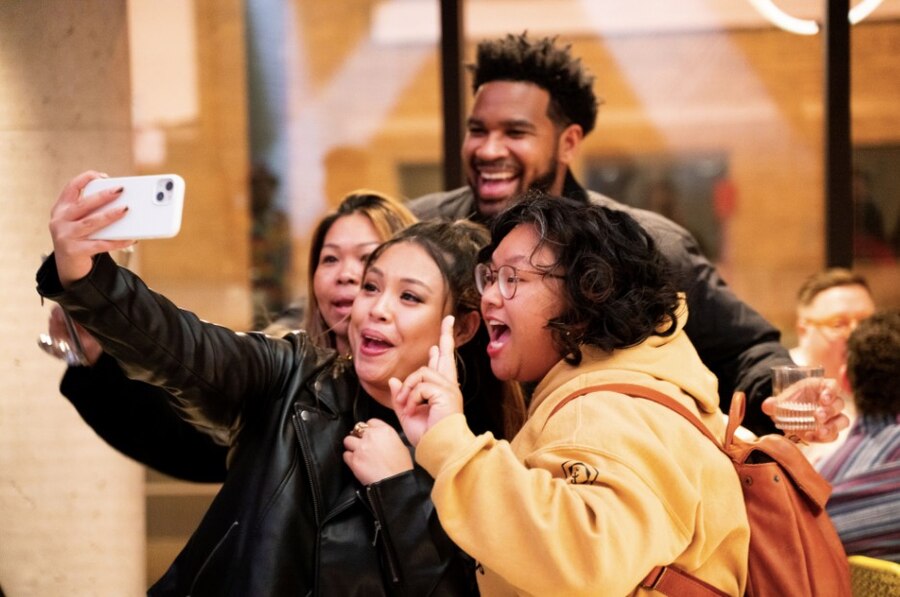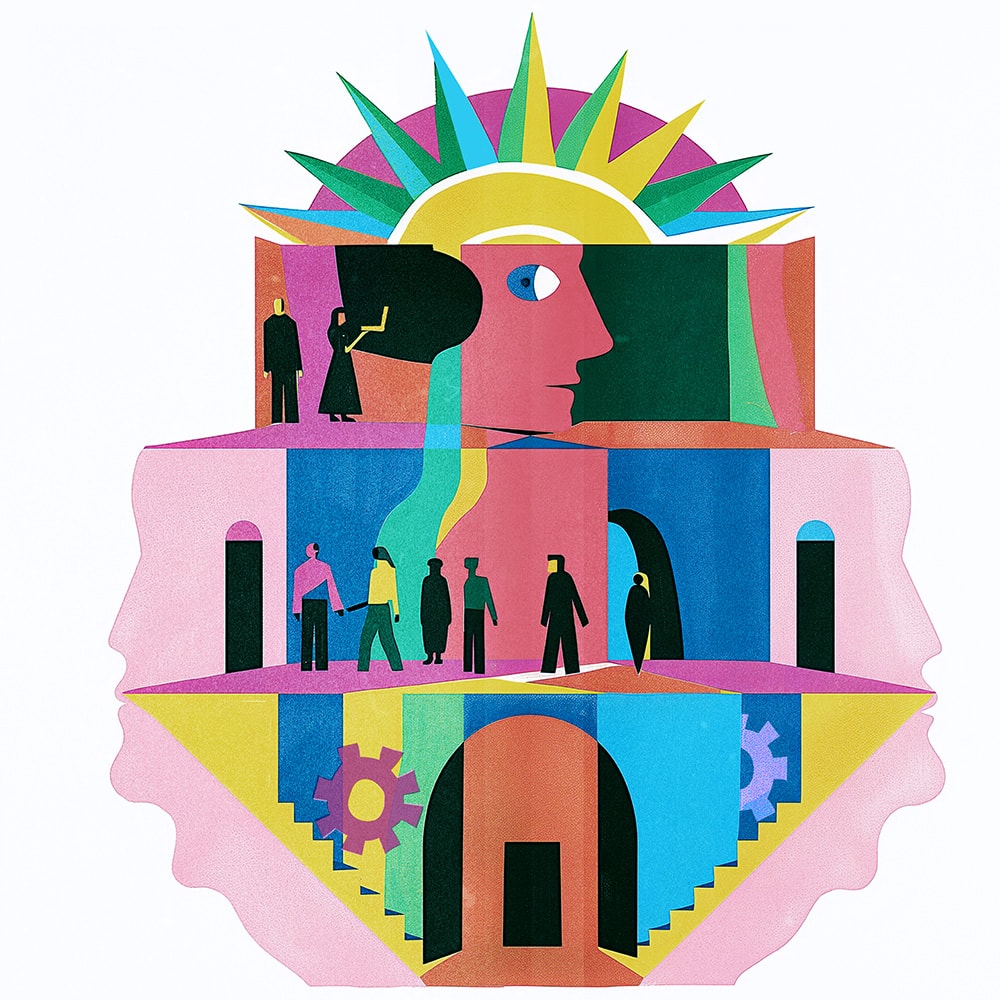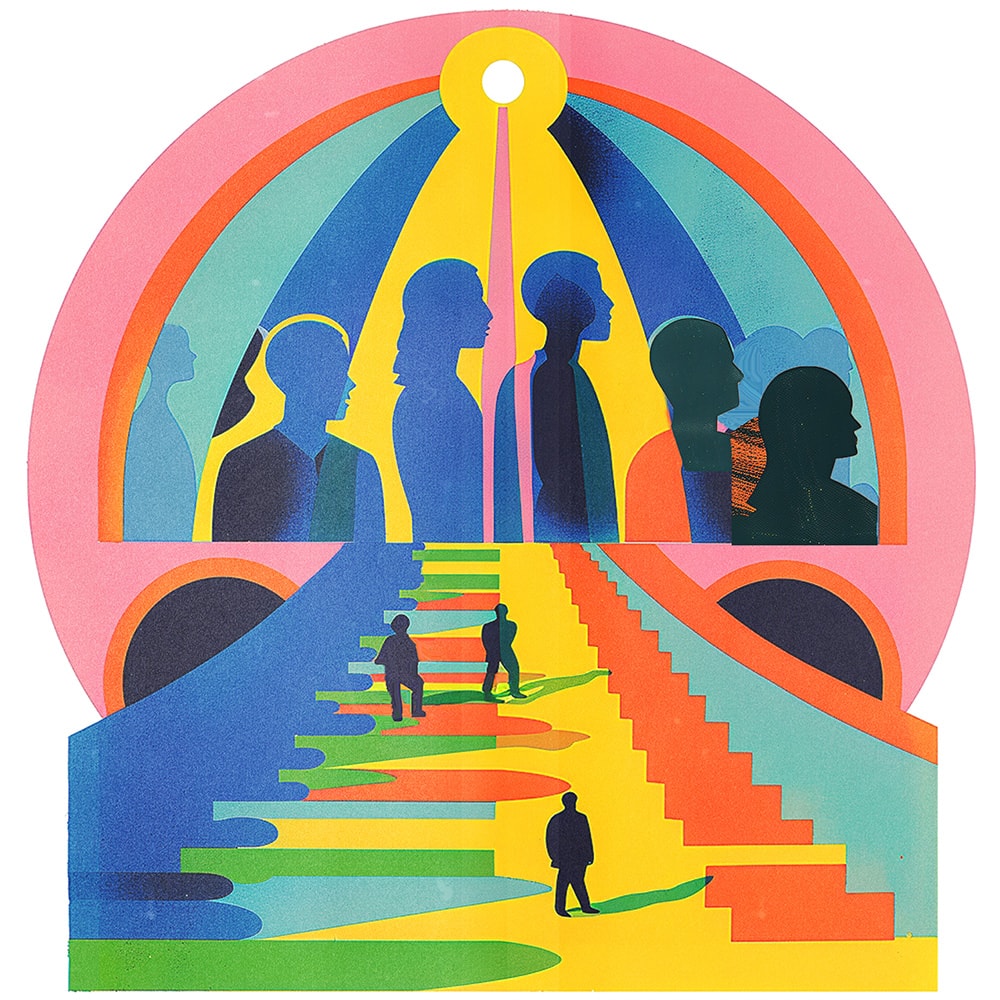As patrons sat in the theatre experiencing the second act of Bald Sisters, Vichet Chum’s relatable yet profound family play, the enticing smell of rich Cambodian food began to fill Steppenwolf Theatre’s lobby. Songs from the show’s playlist mingled with the scent to create an exciting atmosphere. After the performance, new patrons—many young and of Asian descent or with other global majority backgrounds—gathered with long-time Steppenwolf theatregoers to enjoy the festivities. As they swayed together to Cambodian hits and tasted the flavorful food, my spirit soared. This is how diverse and intertwined our audiences should be.
We were able to engage with our audiences this way because of our open communication with Vichet, the playwright, who recommended we work with the National Cambodian Heritage Museum. With just a few months of planning, our collaboration with local community partners helped us to welcome in new audiences, creating a sense of belonging in a space where some may have never felt comfortable before.
How does all this relate to the future? When you consider the brevity of the Reconstruction Era, approximately 1867 to 1877, you can conclude that the U.S. has failed to fully commit to a promise of change in the more than 150 years since. We’ve seen how non-white citizens have been treated: forced deportation of Mexican Americans during the Great Depression, internment of Japanese Americans in the 1940s, and so many other instances over the past century. This time it has taken less than four years to regress, as our nation races away from the social justice progress initiated in 2020 following the murder of George Floyd. The gap between the release of We See You, White American Theater’s demands in the summer of 2020, and the current national retreat from Inclusion, Diversity, Equity, and Accessibility (IDEA) initiatives, is minuscule. What used to be an undercurrent of exclusion is now is being projected boldly and loudly from some quarters.
As an industry, we are compelled to consider how these national changes will present in the arts world. How committed are theatres to authentically recognizing everyone’s humanity? What impact will these setbacks have on future audiences, artists, arts companies—and, on a more personal level, my own career?
This is why I’ve found myself in Chicago, the so-called Second City, one of the most vibrant theatre capitals in North America. In my conversations with Steppenwolf’s leadership team early in 2022, it seemed that the company was committed to forging a genuine path with new audiences. But was this really possible in a city as segregated as Chicago? Arriving from culturally integrated New York City, where I’d worked at major and historic arts organizations, such as Alvin Ailey and the Apollo Theater, I was eager to see if I could both support Steppenwolf’s intentions and help manifest their enhanced vision. The example described above was my first attempt, and our marketing and communications team (along with other departments) has been there to support adventurous experiments over the past couple of years. With buy-in from leadership, fellow staff, ensemble members, and the board, we continue to examine learnings from each activation and partnership we embark on.
Utilizing the power of the arts as a driving force, I am dedicated to bridging the gap between cultures for decades to come. I encourage each arts professional to lead with this mind frame.
We’ve currently been focusing on pre-show conversations and activations, hosted in partnerships with other local and community organizations. While not a novel idea, we have seen a significant amount of success with it, as exemplified through an increase in positive responses to audience surveys and an increase of new patrons. Due to our collaborations, which are intended to be less transactional and more authentic, audiences for these events and performances have become more mixed, with new guests attending in addition to current members.
As the kinds of plays Steppenwolf produces blooms with variety, we’ve conducted membership research to better understand how to serve our expanding audience. From current members and multi-single-ticket buyers, we’ve learned that our audiences need more information to help them prepare for performances. We’ve taken a more active approach to meet this need by updating our marketing plans to include more reference materials (including making our newsletters more robust, with new video offerings, partner programs, etc.), and featuring the voices of our new artistic directors as we highlight why each play is chosen. All of this provides more context for audiences, which helps them process the work they see on our stages. We’re still perfecting these initiatives, and growing pains are par for the course.
Yes, Steppenwolf has received some negative feedback from long-time patrons (through phone calls, emails, and surveys) who miss the old days when our plays were more homogeneous, and who don’t seem ready for the future we’re building. But these have not deterred our new artistic directors’ goals and priorities, nor outweighed the appreciation from current members who are advocates for change, not to mention the “new to file” patrons who have become multi-single-ticket buyers or “flex” members.
My life’s vision is very much in sync with Steppenwolf’s goal for expansion and inclusion. My mantra: Utilizing the power of the arts as a driving force, I am dedicated to bridging the gap between cultures for decades to come. I encourage each arts professional to lead with this mind frame, from administrators to executive and artistic leaders, from run crew members to ushers. We must commit to being welcoming in our offices, creative shops, lobbies, and on our stages. It is the only way our industry, and world, will survive.
Chicago’s legacy of segregation has not made this easy to implement at Steppenwolf. But the staffing changes we are making are helping us fully and authentically support productions on our mainstages and in our black box theatre, where we host our LookOut series for itinerant artists and have helped to create a welcoming atmosphere.
One of our major productions last season was Purpose, by Branden Jacobs-Jenkins (headed for Broadway next February). More than 30 percent of audiences were new patrons, and sales remained strong throughout the run. A Latinx colleague from another theatre company recently told me that she has noticed the changes occurring at Steppenwolf, which was very encouraging.
We can all do our part today to build audiences for tomorrow, and we must, as theatres have little control over funding and donations (on the decline along with memberships). Having contributed to strategy for, and the implementation of, Alvin Ailey’s audience development initiative, funded by Wallace Foundation, this mission of expansion and inclusion remains a priority in my work, and I hope that this is an industry priority as well.
More than 60 years after Martin Luther King Jr.’s “I Have a Dream” speech, in a so-called “post-racial” society, his vision hasn’t yet been widely implemented and sustained in this country—including at our theatres. Those whom society views as “other” have lived most of their entire lives without the core theatrical canon representing them or telling their stories, and it’s past time for the majority to room to flip the script. If all the world’s a stage, our theatres—onstage, in the staff offices, and in the festive lobby after the show—need to reflect that world.
PennyMaria Jackson is a dedicated arts professional, enthusiast, and advocate with more than 15 years of experience. She is now director of marketing and communications for Steppenwolf.
RELATED CONTENT
Support American Theatre: a just and thriving theatre ecology begins with information for all. Please join us in this mission by joining TCG, which entitles you to copies of our quarterly print magazine and helps support a long legacy of quality nonprofit arts journalism.






